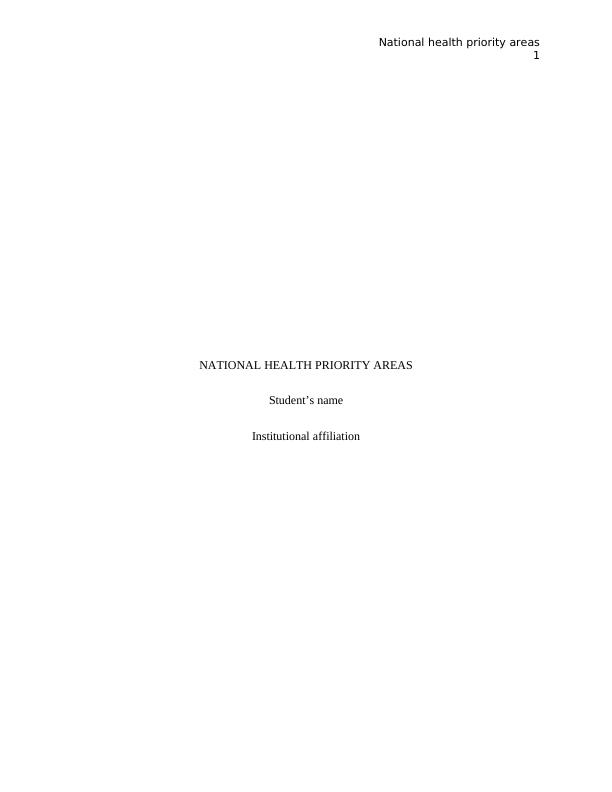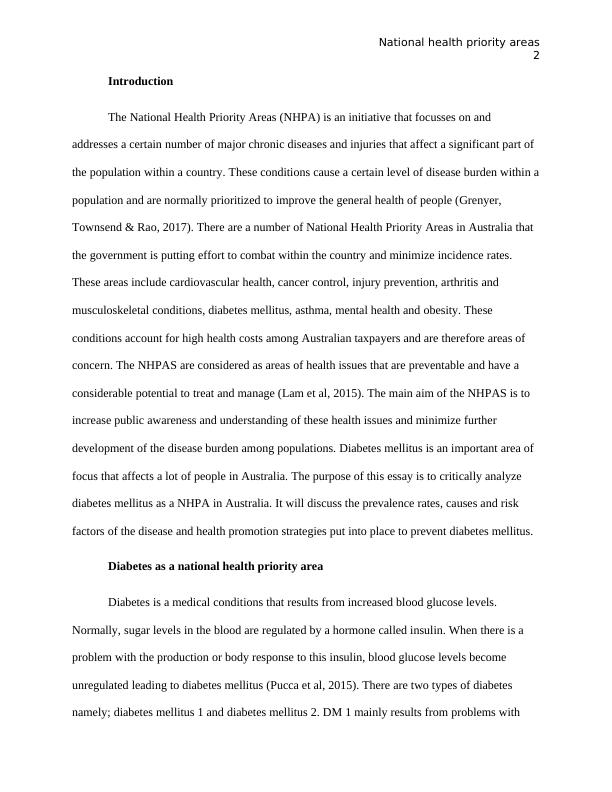The National Health Priority Areas (NHPA)
Added on 2022-10-14
9 Pages2380 Words29 Views
National health priority areas
1
NATIONAL HEALTH PRIORITY AREAS
Student’s name
Institutional affiliation
1
NATIONAL HEALTH PRIORITY AREAS
Student’s name
Institutional affiliation

National health priority areas
2
Introduction
The National Health Priority Areas (NHPA) is an initiative that focusses on and
addresses a certain number of major chronic diseases and injuries that affect a significant part of
the population within a country. These conditions cause a certain level of disease burden within a
population and are normally prioritized to improve the general health of people (Grenyer,
Townsend & Rao, 2017). There are a number of National Health Priority Areas in Australia that
the government is putting effort to combat within the country and minimize incidence rates.
These areas include cardiovascular health, cancer control, injury prevention, arthritis and
musculoskeletal conditions, diabetes mellitus, asthma, mental health and obesity. These
conditions account for high health costs among Australian taxpayers and are therefore areas of
concern. The NHPAS are considered as areas of health issues that are preventable and have a
considerable potential to treat and manage (Lam et al, 2015). The main aim of the NHPAS is to
increase public awareness and understanding of these health issues and minimize further
development of the disease burden among populations. Diabetes mellitus is an important area of
focus that affects a lot of people in Australia. The purpose of this essay is to critically analyze
diabetes mellitus as a NHPA in Australia. It will discuss the prevalence rates, causes and risk
factors of the disease and health promotion strategies put into place to prevent diabetes mellitus.
Diabetes as a national health priority area
Diabetes is a medical conditions that results from increased blood glucose levels.
Normally, sugar levels in the blood are regulated by a hormone called insulin. When there is a
problem with the production or body response to this insulin, blood glucose levels become
unregulated leading to diabetes mellitus (Pucca et al, 2015). There are two types of diabetes
namely; diabetes mellitus 1 and diabetes mellitus 2. DM 1 mainly results from problems with
2
Introduction
The National Health Priority Areas (NHPA) is an initiative that focusses on and
addresses a certain number of major chronic diseases and injuries that affect a significant part of
the population within a country. These conditions cause a certain level of disease burden within a
population and are normally prioritized to improve the general health of people (Grenyer,
Townsend & Rao, 2017). There are a number of National Health Priority Areas in Australia that
the government is putting effort to combat within the country and minimize incidence rates.
These areas include cardiovascular health, cancer control, injury prevention, arthritis and
musculoskeletal conditions, diabetes mellitus, asthma, mental health and obesity. These
conditions account for high health costs among Australian taxpayers and are therefore areas of
concern. The NHPAS are considered as areas of health issues that are preventable and have a
considerable potential to treat and manage (Lam et al, 2015). The main aim of the NHPAS is to
increase public awareness and understanding of these health issues and minimize further
development of the disease burden among populations. Diabetes mellitus is an important area of
focus that affects a lot of people in Australia. The purpose of this essay is to critically analyze
diabetes mellitus as a NHPA in Australia. It will discuss the prevalence rates, causes and risk
factors of the disease and health promotion strategies put into place to prevent diabetes mellitus.
Diabetes as a national health priority area
Diabetes is a medical conditions that results from increased blood glucose levels.
Normally, sugar levels in the blood are regulated by a hormone called insulin. When there is a
problem with the production or body response to this insulin, blood glucose levels become
unregulated leading to diabetes mellitus (Pucca et al, 2015). There are two types of diabetes
namely; diabetes mellitus 1 and diabetes mellitus 2. DM 1 mainly results from problems with

National health priority areas
3
insulin production from the beta cells of the pancreas. On the other hand, diabetes mellitus 2
results from peripheral tissue resistance to insulin leading to raised blood sugar levels. Diabetes
mellitus 2 is the most common among the 2 and mainly affects the older population within the
country. The risk for development of the disease increases with age and therefore people 60
years and above form a major target population (Gibbs et al, 2015). Diabetes mellitus was
identified as a national health priority area in 1996 due to an increase in the disease burden
among the people of Australia. It is considered as a NHPA due to the fact that millions of people
develop the disease within the country annually. The need to prevent development of the disease
is of importance in order to reduce mortality rates among the population.
Statistical data of diabetes in Australia
There are a number of statistical figures that are associated with diabetes in Australia.
About 275 people in Australia for example develop diabetes mellitus every day. This shows the
need to put a lot of emphasis on the awareness of the medical condition. It is one of Australia’s
fastest growing chronic disease and about 970.000 are currently diagnosed with the disease. For
every person that is diagnosed, it is estimated that there is another person that is not yet
diagnosed and therefore the prevalence shoots to as twice as much (Hall et al, 2018). The total
number of Australians with prediabetes and diabetes is estimated to be 3.2 million with the
number increasing every day. This can be compared with the global prevalence of the disease
whereby the disease currently affects at least 422 million people. It is the 6th leading cause of
death among Australians today. This information shows how important it is to address diabetes
mellitus in the country. Its incorporation as a NHPA is therefore of importance and a step
towards eradication of the disease burden.
Risk factors and contributing factors
3
insulin production from the beta cells of the pancreas. On the other hand, diabetes mellitus 2
results from peripheral tissue resistance to insulin leading to raised blood sugar levels. Diabetes
mellitus 2 is the most common among the 2 and mainly affects the older population within the
country. The risk for development of the disease increases with age and therefore people 60
years and above form a major target population (Gibbs et al, 2015). Diabetes mellitus was
identified as a national health priority area in 1996 due to an increase in the disease burden
among the people of Australia. It is considered as a NHPA due to the fact that millions of people
develop the disease within the country annually. The need to prevent development of the disease
is of importance in order to reduce mortality rates among the population.
Statistical data of diabetes in Australia
There are a number of statistical figures that are associated with diabetes in Australia.
About 275 people in Australia for example develop diabetes mellitus every day. This shows the
need to put a lot of emphasis on the awareness of the medical condition. It is one of Australia’s
fastest growing chronic disease and about 970.000 are currently diagnosed with the disease. For
every person that is diagnosed, it is estimated that there is another person that is not yet
diagnosed and therefore the prevalence shoots to as twice as much (Hall et al, 2018). The total
number of Australians with prediabetes and diabetes is estimated to be 3.2 million with the
number increasing every day. This can be compared with the global prevalence of the disease
whereby the disease currently affects at least 422 million people. It is the 6th leading cause of
death among Australians today. This information shows how important it is to address diabetes
mellitus in the country. Its incorporation as a NHPA is therefore of importance and a step
towards eradication of the disease burden.
Risk factors and contributing factors

End of preview
Want to access all the pages? Upload your documents or become a member.
Related Documents
Disease burden in Australia (indigenous and non-indigenous) 5 Comparison of the United States (indigenous and non-indigenous) 5 Disease burden in the University Name of the Author Namelg...
|22
|5639
|37
Diabetes Mellitus Education for Managementlg...
|12
|2407
|127
Lifetime Risk of Diabetes and Obesity in Metropolitan Adelaidelg...
|9
|2306
|67
Diabetes as a National Health Priority in Singaporelg...
|8
|2273
|424
Epidemiology of Diabetes Mellitus Type 2lg...
|13
|2847
|392
National Health Priority Area: Cardiovascular Healthlg...
|10
|2217
|117
